AMD Athlon 64 4000+ & FX-55: A Thorough Investigation
by Anand Lal Shimpi on October 19, 2004 1:04 AM EST- Posted in
- CPUs
Multitasking Content Creation
MCC Winstone 2004
Multimedia Content Creation Winstone 2004 tests the following applications in various usage scenarios:
. Adobe® Photoshop® 7.0.1
. Adobe® Premiere® 6.50
. Macromedia® Director MX 9.0
. Macromedia® Dreamweaver MX 6.1
. Microsoft® Windows MediaTM Encoder 9 Version 9.00.00.2980
. NewTek's LightWave® 3D 7.5b
. SteinbergTM WaveLabTM 4.0f
As you can see above, Lightwave is part of the MCC Winstone 2004 benchmark suite. As an individual application, Lightwave does manage to get a healthy performance benefit with multithreaded rendering enabled, especially when paired with Hyperthreading enabled CPUs like the Pentium 4s here today. The latest MCC Winstone patch allows for a selection of how many threads to launch during the Lightwave test, the options range from 1 - 8 threads.
Based on our tests it seems as if 4 threads yields the highest performance on the Pentium 4 platform, and thus we used that setting for all of our tests. The Athlon 64s perform identically with 1 or 4 threads as they are not multithreading capable processors, so the AMD scores did not change.
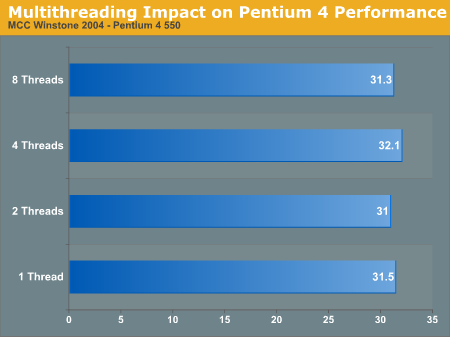
Despite the inclusion of Hyperthreading support, MCC Winstone 2004 still shows AMD performing much better in an area where Intel once dominated. While the Prescott based Pentium 4 560 is at the front of the Intel pack, it is still outperformed by the Athlon 64 3400+.
Here the single vs. dual channel memory gap shrinks to under 3% when we compare the 3400 and 3800+ processors, but also worth noting that the added cache of the 4000+ is also only responsible for about a 2% performance gain. Put the two together and you've got a decent combination in the Athlon 64 4000+, but separately the features don't bring much to the table to justify the added cost.
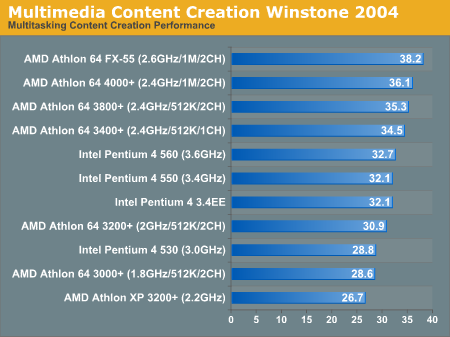
ICC SYSMark 2004
The first category that we will deal with is 3D Content Creation. The tests that make up this benchmark are described below:
"The user renders a 3D model to a bitmap using 3ds max 5.1, while preparing web pages in Dreamweaver MX. Then the user renders a 3D animation in a vector graphics format."
Intel has historically done very well under SYSMark 2004, especially when it comes to Internet Content Creation applications. Here we've got a number of very NetBurst friendly applications running at the same time and the results aren't too surprising.
For once we have the Pentium 4 560 out on top, distancing itself from the Athlon 64 FX-55 by almost 5%. The Prescott core flexes its muscle as the longer pipeline does it no harm, with the Pentium 4 550 performing on level ground with the Northwood based 3.4EE.
The three 2.4GHz AMD chips settle in the middle of the pack, followed by the Pentium 4 530 and the remaining Athlon 64s and Athlon XP. 3D rendering continues to be a strongpoint for the Pentium 4, with the combination of 3D rendering and animation giving Intel the much needed lead here.
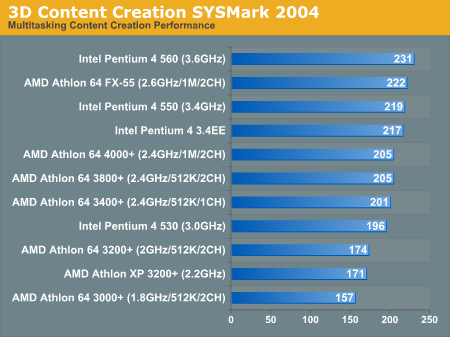
Next, we have 2D Content Creation performance:
"The user uses Premiere 6.5 to create a movie from several raw input movie cuts and sound cuts and starts exporting it. While waiting on this operation, the user imports the rendered image into Photoshop 7.01, modifies it and saves the results. Once the movie is assembled, the user edits it and creates special effects using After Effects 5.5."
The race is much closer in the 2D Content Creation test, with the Pentium 4 560 virtually tied for the lead with AMD's Athlon 64 FX-55.
Once again we see no difference between the 512KB L2 3800+ and the new 4000+ armed with a 1MB L2 cache. There continues, however, to be a slight performance impact when going down to the single channel Athlon 64 3400+.
Looking at the Athlon XP we see just how important the Athlon 64 has been
to AMD, without it we'd be analyzing another Intel dominated test.
Here's another situation where Prescott seems to be breaking even when
it comes to performance. Remember that Prescott's lengthened pipeline should
penalize it significantly, but thanks to Prescott's other core optimizations
and larger cache it manages to perform just as well as the Northwood based
Extreme Edition here.
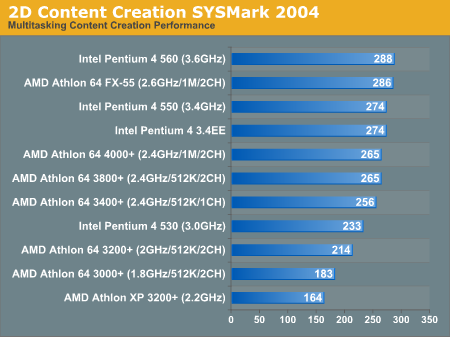
The Internet Content Creation suite is rounded up with a Web Publishing performance test:
"The user extracts content from an archive using WinZip 8.1. Meanwhile, he uses Flash MX to open the exported 3D vector graphics file. He modifies it by including other pictures and optimizes it for faster animation. The final movie with the special effects is then compressed using Windows Media Encoder 9 series in a format that can be broadcast over broadband Internet. The web site is given the final touches in Dreamweaver MX and the system is scanned by VirusScan 7.0."
The situation remains mostly unchanged in SYSMark's final Internet Content Creation test. The Pentium 4 560 heads up the pack, followed very closely by the Athlon 64 FX-55 as well as the Pentium 4 550 and 3.4EE.
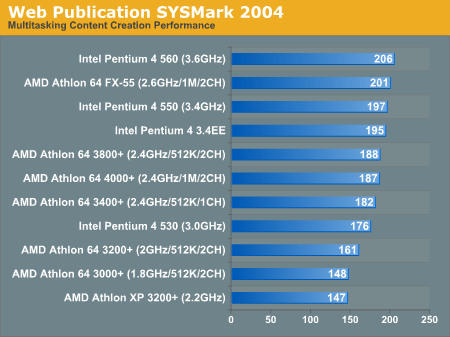
Mozilla + Media Encoder
While AMD dominated in WorldBench 5's Mozilla test, encoding a file using Windows Media Encoder in the background not only makes this test more appreciative of the Pentium 4 but also of Hyper Threading.
Despite the seemingly perfect Hyper Threading scenario, it doesn't help Intel win the lead here. The Athlon 64 FX-55 and the 4000+ manage to win here, followed by the 3.4EE. Without any spatial locality between the two very different applications being run enabling Hyper Threading essentially gives each one of the applications half of the cache they would have running solo, thus giving the 3.4EE an advantage over the Pentium 4 560.
We also see that the cache advantage is clearly present on the AMD side as well, with the 4000+ enjoying a 6.7% advantage over the 3800+, with the only difference between the chips being an additional 512KB of L2 cache.
The rest of the results are no surprise given the leaders, the Athlon 64 continues to be quite strong here.
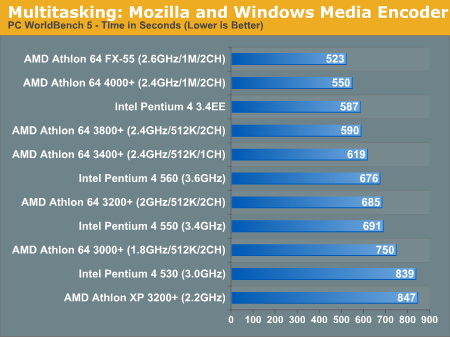










89 Comments
View All Comments
HardwareD00d - Tuesday, October 19, 2004 - link
Fantastic article, obviously very well thought out.I would have liked to see a comparison between the 4000+ and the "real" FX-53 to really back up your rebadging theory (yeah I know speed+cache+memory width are equal between the two, but just to make sure AMD isn't pulling some magic out of there butt somewhere else).
Marsumane - Tuesday, October 19, 2004 - link
Yes, thanks for the XP comparison. I find it interesting how its not performing as well as it used to in games. (doom 3, farcry, cs:s)Also, your ut2k4 benches seem off. How is doom 3 pulling 50% more frames at the same res? Maybe your ut is at 16x12? I pull similar frames on ut w/ my 9800p oced.
ksherman - Tuesday, October 19, 2004 - link
I like the ending... It sounds mysterious!alexruiz - Tuesday, October 19, 2004 - link
I will suggest again to include some Ulead Video Studio 8.0 benchmarks for video encoding. Ulead is by far the fastest consumer grade video editor / renderer, it is the most complete and one of the most popular. In fact, it is almost 50% faster than Pinnacle 9, and almost 100% faster than videowave.Roxio has really been working with Intel as all previous version of video wave ran better on AMD hardware. As reference, results video wave 6 or 7 would be interesting. Newer doesn't always mean better, as you can see from Adobe Premiere. Version 7.0 is quite slower than 6.5 doing the exact same thing in the same platform.
For DivX encoding, a run with virtualdub/virtualdubmod or DVD2AVI would be nice, as they are very fast and extensively used.
Just some comments
Alex
Araemo - Tuesday, October 19, 2004 - link
Thank you thank you thank you for including an Athlon XP.This allows me to better judge where my current Barton 2.4 Ghz sits. ;P So I know when an upgrade to the next cheap overclocker will give a good enough performance boost to be worth the money.
stephenbrooks - Tuesday, October 19, 2004 - link
Here's an idea to play with: how about some 2D scatter plots of Performance/£ and Performance/Watt? Obviously not on everything - that would clutter it - but perhaps on one or two key things it'd be nice to see.Zar0n - Tuesday, October 19, 2004 - link
EDIT #22 There is no 3400+ for SK 939 only 3500+Zar0n - Tuesday, October 19, 2004 - link
Nice article BUT:You should make C&C power consumption and temperature
Also some OC tests.
The Battle for Value is not correct:
1º WHAT about price of DDR1 VS DDR2?!
2º MB for INTEL are more expensive, ~40€ is a great difference in a MB price.
3º 0.09 AMD are just introduced so they are going to come down, not much but they are.
In order to be fair you should compare with AMD 3400+
AMD as a clear winner here.
mczak - Tuesday, October 19, 2004 - link
power consumption at idle - is this with or without cool 'n' quiet (I suspect without)?Uff - Tuesday, October 19, 2004 - link
I have to agree with #18 - it's not worth paying more than twice the price of a 3400+ just to get 3800+ on 939 platform.Many say 'OH! But s939 is more upgradable!', but if you think about it, by the time you upgrade next there are very likely going to be new motherboards available aswell and you end up upgrading that anyway. Not to mention motherboards cost virtually nothing compared to cpus.